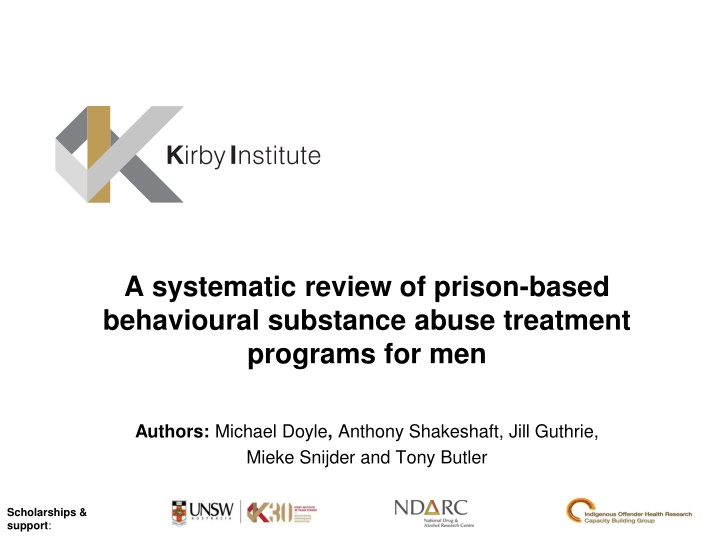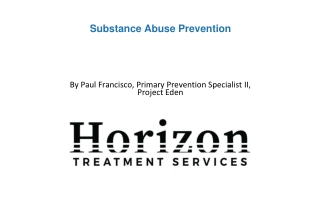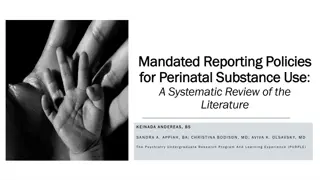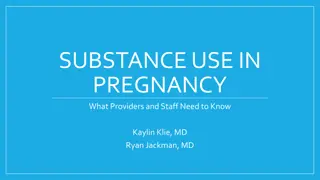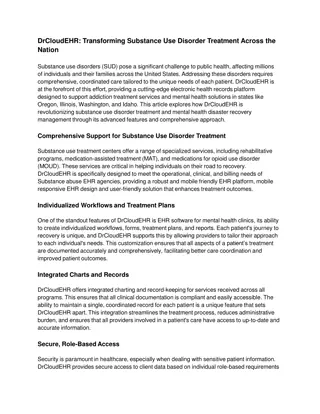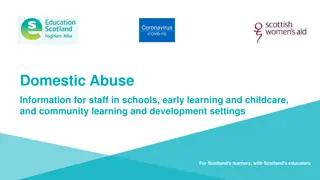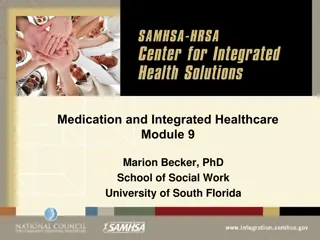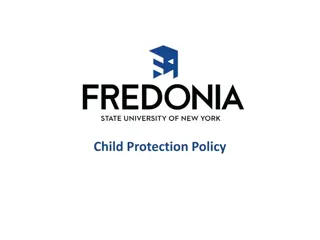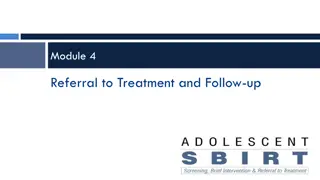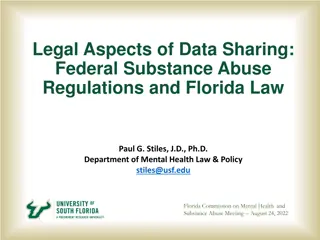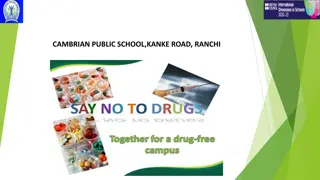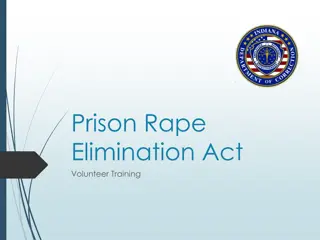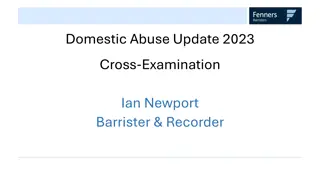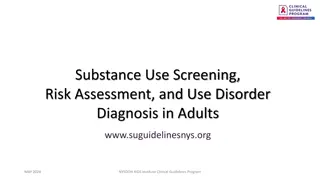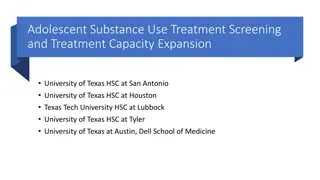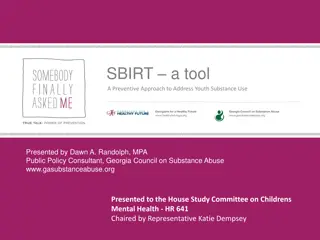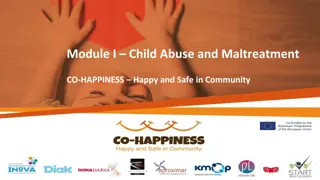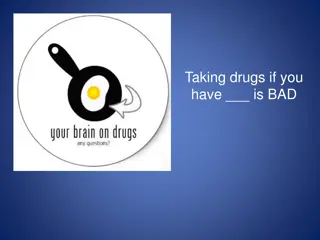A systematic Review of prison-based behavioural Substance Abuse Treatment Programs for men
This systematic review explores the effectiveness of behavioural substance abuse treatment programs in male prisons. Written by Michael Doyle, Anthony Shakeshaft, Jill Guthrie, Mieke Snijder, and Tony Butler. The review delves into the impact of such programs on incarcerated men and offers valuable insights for scholars and individuals involved in correctional or rehabilitation settings.
Download Presentation

Please find below an Image/Link to download the presentation.
The content on the website is provided AS IS for your information and personal use only. It may not be sold, licensed, or shared on other websites without obtaining consent from the author.If you encounter any issues during the download, it is possible that the publisher has removed the file from their server.
You are allowed to download the files provided on this website for personal or commercial use, subject to the condition that they are used lawfully. All files are the property of their respective owners.
The content on the website is provided AS IS for your information and personal use only. It may not be sold, licensed, or shared on other websites without obtaining consent from the author.
E N D
Presentation Transcript
A systematic review of prison-based behavioural substance abuse treatment programs for men Authors: Michael Doyle, Anthony Shakeshaft, Jill Guthrie, Mieke Snijder and Tony Butler Scholarships & support:
Prison-based alcohol and other drug use treatment for Aboriginal and non-Aboriginal men Background PhD Chapter one - Introduction and background Chapter two - Systematic Review Chapter three - Alcohol and other drug use among Aboriginal and non- Aboriginal men entering prison in NSW Chapter four - Experiences of previous AoD treatment of men entering an intensive drug and alcohol treatment program in a correctional facility Chapter five - AoD treatment experiences of Aboriginal men in prison Chapter six - Discussion and conclusions
Prison-based alcohol and other drug use treatment for Aboriginal and non-Aboriginal men A systematic review of prison-based behavioural substance abuse treatment programs for men Originally intended to be Indigenous specific, but was broadened due to the lack of Indigenous specific papers. Focus on behavioural treatment excluding Pharmacotherapies (methadone) Co-morbidity (mental health) Previous reviews: Pearson F, Lipton DS. A Meta-Analytic Review of the Effectiveness of Corrections-Based Treatments for Drug Abuse. The Prison Journal 1999; 79(4): 384-410. (1968-1996) Mitchell O, Wilson DB, MacKenzie DL. The Effectiveness of Incarceration-Based Drug Treatment on Criminal Behaviour. Oslo, Norway: Campbell Collaboration; 2006. (1980-2004)
Prison-based alcohol and other drug use treatment for Aboriginal and non-Aboriginal men A systematic review of prison-based behavioural substance abuse treatment programs for men Inclusion criteria Prison-based substance abuse treatment Exclusion criteria Papers that related to previously published data Treatment participants are prison inmates Pharmacotherapy based substance abuse treatment Research participants are men only, or men and women prisoners Mental health and substance abuse comorbidity treatments Published 1 January 1995 to 3 1 December 2015 Grey literature Available in English
Prison-based alcohol and other drug use treatment for Aboriginal and non-Aboriginal men A systematic review of prison-based behavioural substance abuse treatment programs for men Methodology: PRISMA - Preferred Reporting Items for Systematic Reviews and Meta-Analyses Dictionary for Effective Public Health Practice Project and associated Quality Assessment Tool for Quantitative Studies Long and Godfrey s (2004): An Evaluation Tool to Assess the Quality of Qualitative Research Studies Independently review Search strategy Word strings covering four domains were used: 1) Participant group or setting; 2) Substance abuse disorders; 3) Provision of treatment or care; and 4) Identifying as being research/evaluation: 1) Prison OR gaol OR jail OR detain* OR arrest* OR justice or (justice system) OR crim* OR (criminal justice) OR offend* OR parol* OR probation OR correction* or (correctional centre) or (correctional center) or (correctional facility) or (correctional institution) or (correctional service).
Prison-based alcohol and other drug use treatment for Aboriginal and non-Aboriginal men Identification Searched data bases Informit (n=3,201); OVID & Cochrane Library (n=2,027); Campbell Library (n=21); Web of Science (n=1,950); CINAHL (n=2,412); Scopus (n=2,824); and the Project Cork database (n=612) 7,898 duplicates removed 13,047 Retrieved Screening 4,391 removed after screening key words and titles 5,149 Remaining Eligibility 758 Records after eligibility screening 513 removed at abstracts review 23 reviews 20 AoD treatment provision Classification 245 Prison based AoD research 85 treatment theory & development 29 screening & clinical 88 AoD treatments 63 removed after full-text review: not original data post-prison or indistinguishable treatments appraisal Critical 25 Papers suitable for inclusion
Prison-based alcohol and other drug use treatment for Aboriginal and non-Aboriginal men Author Country Aim/approach Eligibility & exclusion criteria Treatment duration & group size; Arseneault (2015) Canada Psychoeducational program, with a harm reduction, motivational & CBT approach, incorporated academic. Minimum security & 42 days prior to release; moderate to severe alcohol/drug use, motivated to receive help; literate, able to function in group. Inmates with mental a disorder not controlled by medication were excluded from the program. 42 days; group size=14 Linhorst (2012) United States Psychoeducational program incorporating 12-step & recovery model of Alcoholics, Narcotics or Cocaine Anonymous. Entry by Court order if community option have failed or are not appropriate, participant must agree to placement. Court can order placement in cases of parole revocation. Exclusion criteria not specified. 90 days; group sizes, 30 in men s & 15 per women s group Pelissier (2001) United States CBT based group programs covering lifestyle choices & drug use, relapse prevention & anger management. Program entry and exclusion criteria to moderate (mod) & high intensity programs not specified. Mod 274 days; group size not stated - High 365 days ; group size not stated Residential Raney (2005) United States CBT day attendance treatment program covering choices & drug use, relapse prevention Program entry and exclusion criteria not specified other than being minimum security for entry 274 days; group size 30 Staton (2000) United States Program based on AA 12-Step program and additional focus on linking cognition with behavior Program is for inmates with self-admitted AoD problems & offences related to AoD. None violent and other less criminal charges 182 days; group size not stated Turley (2004) United States Based on AA 12-Step. Later sessions in program focus on staying sober. Post-prison component Non-violent inmates with history of AoD use are eligible to volunteer for program. Exclusion criteria not stated. 60 to 90 days; group size not stated Vaughn (2003) Taiwan Psychoeducational programwith education classes, taught in lecture format with limited interaction. If assessed as requiring AoD treatment inmates are mandated to complete program. Assessment inclusion, exclusion criteria not specified. 90 days; group size not stated Bowen (2006) United States Vipassana mindfulness meditationstudy, teaching mindfulness & detachment from emotional situations Study located in an AoD treatment facility with all inmates eligible to volunteer for control or treatment groups. 10 days; group size not stated Matsumoto (2014) Japan Staff can place inmates in program if the reason for imprisonment is drug abuse or if drug abuse may impede social adjustment. No exclusion criteria specified. Book 32 days; group size 30 - day attendance90 days; group size 10; drug treatment prison CBT approach program using day attendance model& classes with self-learning workbook based on MATRIX program. Drug treatment priso Vukadin (2004) Croatia AoD treatment prison with 2 x programs described as modified TC s with 12-Step program incorporated. Additional psychoeducational component covering alcohol education. Post-prison AA & NA encouraged. Court ordered or if sentence is 182 days phycologists can order placement. No entry or exclusion criteria specified. Days not stated; group size not stated Inciardi (1997) United States 3 stage TC program(incarceration, work release, parole): approach to treating the whole person not just the drug use, with aim to enhance prosocial behaviours & to change behaviour, negative thinking and feelings that pre-dispose to drug use. Post-prison component Eligibility & exclusion criteria for program were not specified Key & WCI village 365 days, Crest duration not stated; grp sizes not stated Joe (2010) United States 3 treatment program modalities: 2 x TC using Matrix Model. Methamphetamine TC graduates involved in peer teaching. 1 x psychoeducational group program All inmates screened on entry to prison & those in need of AoD treatment offered placement in a program. No other detail provided on entry or exclusion criteria TC s 182 to 274 days, Group program not clear 98 days; group sizes not stated TC program addressing AoD relapse, reasons for drug use, preparation for release, work release component & post- prison care component. Knight (1997) United States Inmates screened for drug use history on prison entry. When inmates have 270 to 300 days left to serve the Treatment Referral Committee make recommendations to Parole Board. Inmates excluded if offences are violence or sexual related TC & CTC 274 days, TC group size 25 to 50, CTC grp size not stated Therapeutic Communities Lee (2014) South Korea TC program, adapted form United States but specific model not described Voluntary program participation for men sentenced to 182 to 365 days with convictions of criminal activities related to substance abuse. No program exclusion criteria specified TC s 182 days, group size not stated Stohr (2002) United States 2 x TC programs with social learning theory applied using a CBT model. AA & NA 12-step components included Verified AoD abuse (definition not specified) with program 1 being parole violators & 2 regular termers . No program exclusion criteria specified. 274 to 365 days; group size not stated Welsh (2007) United States TC program, addressing criminal thinking and AoD use behaviour and develop skills for relapse prevention Triage approach but entry and exclusion criteria not specified 274 to 504 days; group size not stated TC Welsh (2010) United States TC program, addressing criminal thinking and AoD use behaviour and develop skills for relapse prevention 540 to 1020 days to serve, documented history of AoD (minimum score 3 on TCU Drug Screen 2), medium to low security, no serious mental health problems 365 days; group size not stated Wexler (1999) United States TC program. Addressing criminal thinking and AoD use behaviour and develop skills for relapse prevention. Post-prison care component Voluntary entry for inmates with drug problem (no case definition), minimum 270 to 420 days to serve. Inmates convicted of arson or sexual crimes are excluded 182 to 274 days; group size not stated Bowes (2012) Wales CBT approach study covering problem solving, coping with high risk situations & managing anger & stress History of alcohol related violence during 2 years prior to prison, medium to high risk of re-offending. Excludes acute mental illness/impairment, interment life sentence, inmates convicted of sexual offences. 30 days; group size = 8 to 10; Chaple (2014) United States Interactive computerised AoD education program Diagnosed moderate to low level substance use disorder, not currently receiving treatment, parole review or release 120 to 180 days. No exclusion criteria stated 90 days; group size not stated Crundall (1997) Australia Psychoeducational program using social learning model with specific adaptations for Aboriginal Australians No program entry or exclusion criteria specially stated. Duration not stated; group size not stated Davis (2014) Canada Programs using social-cognitive theory and incorporates relapse prevention therapy and CBT. High intensity includes managing dependency & countering addictive beliefs Offenders were eligible for program and study, if AoD were implicated in their offense & if they had moderate to severe substance use problems. No exclusion criteria stated for program 42 (mod) & 140 days (high); group size not stated Group treatment Gossage (2003) United States Study into the use of traditional Native American healing methods involving song and prayer in a sweat lodge setting to enhance or re-establish belief systems and practises that increase resilience. Alcohol education incorporated Voluntary participation in study, with the exception of maximum security being excluded Duration not stated; group size Lee (2011) Taiwan Study using mindfulness meditation classes incorporating stress reduction, CBT & relapse prevention Study inmates must have 1 year sentence due to drug possession or sale. Have past illicit drug use & had been abstinent in the past 182 days. Illiterate inmates & those with acute mental illness were excluded 70 days; group size not stated Slaski (2006) Poland Program is an adapted from AA 12-Step. Enhancement in self- awareness, acceptance of inability to control psychoactive substance use Admitted to program if alcoholic or alcohol dependent (no case definition provided), no exclusion criteria specified. 90 days; group size not stated
Prison-based alcohol and other drug use treatment for Aboriginal and non-Aboriginal men Table 1: Substance abuse treatment characteristics (n=25) Author Country Aim/approach Eligibility & exclusion criteria Treatment duration & group size; Pelissier (2001) United States CBT based group programs covering lifestyle choices & drug use, relapse prevention & anger management. Program entry and exclusion criteria to moderate (mod) & high intensity programs not specified. Mod 274 days; group size not stated - High 365 days ; group size not stated Residential Inciardi (1997) United States 3 stage TC program(incarceration, work release, parole): approach to treating the whole person not just the drug use, with aim to enhance prosocial behaviours & to change behaviour, negative thinking and feelings that pre-dispose to drug use. Post-prison component Eligibility & exclusion criteria for program were not specified Key & WCI village 365 days, Crest duration not stated; grp sizes not stated Therapeutic Communities Knight (1997) United States TC program addressing AoD relapse, reasons for drug use, preparation for release, work release component & post-prison care component. Inmates screened for drug use history on prison entry. When inmates have 270 to 300 days left to serve the Treatment Referral Committee make recommendations to Parole Board. Inmates excluded if offences are violence or sexual related TC & CTC 274 days, TC group size 25 to 50, CTC grp size not stated Welsh (2007) United States TC program, addressing criminal thinking and AoD use behaviour and develop skills for relapse prevention Triage approach but entry and exclusion criteria not specified 274 to 504 days; group size not stated TC
Prison-based alcohol and other drug use treatment for Aboriginal and non-Aboriginal men Treatment characteristics (n=25) USA (n=15), Canada (n=2), Taiwan (n=2), Australia (n=1), Croatia (n=1), Japan (n=1), Poland (n=1), United Kingdom (n=1), South Korea (n=1) Treatment settings Therapeutic community (n=8) [post-prison care x 3] Residential treatment (n=7) [post-prison care x 1] Group treatment (n=7) [post-prison x 0] Therapeutic prison facility (n=3) [post-prison care x 1] Treatment approaches described Cognitive behavioural therapy (n=8) 12-Step program e.g. Alcoholics Anonymous (n=6) Psychoeducational (n=6) Therapeutic community (n=9) MATRIX model (n=2) Meditation/mindfulness (n=2)
Prison-based alcohol and other drug use treatment for Aboriginal and non-Aboriginal men Confou nders controll ed Strong Withdrawa l & drop-out Selection bias Intervention integrity Global rating Author Sample Study Design Data collection methods 96% of intervention group completed treatment. Treatment had curriculum. Attendance to other treatments not reported. Arseneault (2015) Men N=150 Intervention: n=80 Controls: n=70 Men & women N=1,151 Moderate Clinical-referral Moderate Controlled clinical trial Randomisation: No Strong Routine data: Yes Self-report: Yes Validated tools: Yes (1-13) Weak Routine data: Yes Self-report: Yes Validated tools: No Weak Routine data: Yes Self-report: Yes Validated tools: No Strong Strong Only graduates included in analysis. Treatment had curriculum. Attendance to other treatments not reported. Linhorst (2012) Moderate Clinical-referral or mandated Moderate Cohort analytic Randomisation: No Weak Weak Weak Only graduates included in analysis. 75% men and 59% of women in intervention group completed treatment. Treatments had curriculum. Attendance to other treatments not reported. Treatment attendance not reported. Treatment had curriculum. No other treatment attended. Pelissier (2001) Men & women N=1,569 Intervention: n=760 Controls: n=809 Moderate Clinical-referral Moderate Cohort analytic Randomisation: No Modera te Moderate Moderat e Residential treatment Raney (2005) Men & women N=87 Moderate Clinical-referral [ Weak Cohort Randomisation: No Strong Weak Routine data: No Self-report: Yes Validated tools: No Weak Routine data: Yes Self-report: Yes Validated tools: No Weak Routine data: No Self-report: Yes Validated tools: No Weak Weak Only graduates included in analysis. Treatment had curriculum. No other treatment attended. Turley (2004) Men N=411 Moderate Clinical-referral Moderate Times series analysis Randomisation: No Weak Moderate Weak Intervention group completed treatment. Treatment had curriculum. No other treatment attended. Vaughn (2003) Men & women N=698 Intervention: n=304 controls: n=394 Moderate Clinical-referral/ mandated Moderate Cohort analytical Randomisation: No Weak Moderate Weak Only graduates included in analysis. Treatment had curriculum. Intervention group able to attend other AoD treatments (no data recorded). Bowen (2006) Men & women N=173 Intervention: n=57 Controls: n=116 Weak Self-referral Moderate Cohort analytic Randomisation: No Modera te Strong Routine data: Yes Self-reported data: Yes Validated tools:Yes (14-19) Weak Weak Drug treatment prison Intervention group completed treatment. Treatment had curriculum. No other treatment attended. Matsumoto (2014) Men N=251 Moderate Clinical-referral Weak Cohort Randomisation: No Weak Strong Routine data: Yes Self-report: Yes Validated tools: Yes (20, 21) Weak Routine data: No Self-report: Yes Validated tools: No Weak Routine data: Yes Self-report: Yes Validated tools: No Strong Routine data: Yes Self-report: Yes Validated tools: Yes (22-26) Strong Routine data: Yes Self-report: Yes Validated tools: Yes (27-33) Strong Routine data: No Self-report: Yes Validated tools: Yes (34) Strong Weak Treatment attendance not reported. Treatment has curriculum. No other treatment attended. Vukadin (2004) Men N=108 Intervention: A n= 63 Intervention B n=46 Men & women N=448 Moderate Clinical-referral & mandated Weak Cohort Randomisation: No Weak Not applicable Weak Treatment attendance not reported. Treatments had curriculum. Attendance to other treatments not reported. Inciardi (1997) Moderate Clinical-referral Moderate Cohort analytical Randomisation: No Strong Strong Moderat e Therapeutic Communities Only graduates included in analysis. Treatments had curriculum. Attendance to other treatments not reported. Joe (2010) Men N=2,026 Moderate Clinical-referral Moderate Cohort analytical Randomisation: No Strong Moderate Moderat e Only graduates included in analysis. Treatment had curriculum. Attendance to other treatments not reported. Knight (1997) Men N=414 Intervention: n=293 Controls: n=121 Men N=48 Intervention: n=24 Controls: n=24 Moderate Clinical-referral Moderate Cohort analytical Randomisation: No Strong Strong Strong Intervention group completed treatment. Treatment had curriculum. Contamination present with 75% of controls also received one to one counselling. Lee H (2014) Weak Self-referral Strong Controlled Clinical trial Randomisation: Yes, not described Strong Strong Moderat e Treatment attendance not reported. Treatment had curriculum. No other treatment attended. Stohr (2002) Men N=82 Moderate Clinical-referral or mandated Weak Cohort Randomisation: No Strong Weak Routine data: No Self-report: Yes Validated tools: No Strong Routine data: Yes Self-report: Yes Validated tools: Yes (35, 36) Weak Weak Therapeutic Communities Intervention group completed treatment. 5 different TC interventions, authors state high consistence between treatments. Treatment has curriculum. Attendance to other treatments not reported. All participants completed treatment. Treatment has curriculum. Attendance to other treatments not reported. Welsh (2007) Men N=708 Intervention: n=217 controls: n=491 Moderate Clinical-referral Moderate Cohort analytical Randomisation: No Strong Moderate Strong Welsh (2010) Men N=347 Moderate Clinical-referral Weak Cohort Randomisation: No Modera te Strong Routine data: Yes Self-report: Yes Validated tools: Yes, (32, 33) Strong Routine data: Yes Self-report: Yes Validated tools: Yes, (30, 37-42) Strong Routine data: No Self-report: Yes Validated tools: Yes (43-47) Moderate Moderat e Intervention group completed treatment. Treatment has curriculum. No other treatment attended. Wexler (1999) Men & women N=715 Intervention: n=42 Controls: n=290 Men N=115 Intervention: n=56 Moderate Clinical-referral, Strong Controlled clinical trial Randomisation: Yes. Not described Strong Randomised control trial Randomisation: Yes, & described Strong Strong Strong 68% of intervention group completed treatment. Treatment had curriculum. 64% of intervention & 34% of controls attended individual drug counselling. Bowes (2012) Strong Clinical-referral Modera te Strong Strong Group Treatment Controls: n=59 Men & women N=494 Intervention: n=249 Controls n=245 Men N=58 Intervention: n=45 50% of intervention group completed treatment (recorded at only one site). Computerised curriculum. Attendance to other treatments not reported. Chaple (2014) Moderate Clinical-referral Strong Controlled clinical trial Randomisation: Yes, not described Moderate Cohort analytic (Randomisation: No) Strong Weak Routine data: No Self-report: Yes Validated tools: No Weak Routine data: Yes Self-report: Yes & 3rd party Validated tools: No Strong Moderat e Treatment attendance not reported. Treatment had curriculum. Attendance to other treatments not reported. Crundall (1997) Moderate Clinical & Self- referral Weak Weak Weak
Prison-based alcohol and other drug use treatment for Aboriginal and non-Aboriginal men Table 2: Appraisal of quantitative papers (n = 24) Withdrawa l & drop-out Moderate Selection bias Confounders controlled Data collection methods Intervention integrity Global rating Author Sample Study Design [ Only graduates included in analysis. 75% men and 59% of women in intervention group completed treatment. Treatments had curriculum. Attendance to other treatments not reported. Pelissier (2001) Men & women N=1,569 Intervention: n=760 Controls: n=809 Moderate Clinical- referral Moderate Cohort analytic Randomisation: No Moderate Weak Routine data: Yes Self-report: Yes Validated tools: No Moderate Residential Treatment attendance not reported. Treatments had curriculum. Attendance to other treatments not reported. Inciardi (1997) Men & women N=448 Moderate Clinical- referral Moderate Cohort analytical Randomisation: No Strong Weak Routine data: Yes Self-report: Yes Validated tools: No Strong Moderate Therapeutic Communities Only graduates included in analysis. Treatment had curriculum. Attendance to other treatments not reported. Knight (1997) Men N=414 Intervention: n=293 Controls: n=121 Moderate Clinical- referral Moderate Cohort analytical Randomisation: No Strong Strong Routine data: Yes Self-report: Yes Validated tools: Yes (27-33) Strong Strong Intervention group completed treatment. 5 different TC interventions, authors state high consistence between treatments. Treatment has curriculum. Attendance to other treatments not reported. Welsh (2007) Men N=708 Intervention: n=217 controls: n=491 Moderate Clinical- referral Moderate Cohort analytical Randomisation: No Strong Strong Routine data: Yes Self-report: Yes Validated tools: Yes (35, 36) Moderate Strong
Prison-based alcohol and other drug use treatment for Aboriginal and non-Aboriginal men Appraisal of quantitative papers (n = 24) Global rating: Strong (n=5): Arseneault (2015) , Bowes (2012) , Knight (1997) , Welsh (2007) , Wexler (1999) Moderate (n=6): Chaple (2014), Inciardi (1997) , Joe (2010) , Lee H (2014) , Lee K-H (2011), Pelissier (2001) Weak (n=13): Welsh (2010), Bowen (2006), Crundall (1997), Davis (2014), Gossage (2003), Linhorst (2012), Matsumoto (2014), Raney (2005), Slaski (2006), Stohr (2002), Turley (2004), Vaughn (2003), Vukadin (2004) Study design Strong: Randomised control trial (n=1), clinical control trial (n=5) Moderate: Cohort analytical (n=11), Weak: Cohort (n= 6), time series (n=1) Selection bias: Strong [no bias] (n=1) Moderate (n=17) Weak (n=6) Data collection: Strong: validated survey tools (n=12) 53 survey tools catalogued Moderate: survey based on a validated survey tool (n=1) Weak: none validated survey tools (n=11)
Prison-based alcohol and other drug use treatment for Aboriginal and non-Aboriginal men Appraisal of quantitative papers (n = 24) Exposure level to the AoD treatment program: Directly reported in 4 papers. Though, participants were reported as graduates or to have completed program in 13 papers. Unintended exposure to similar program: It is likely that the residential and therapeutic community treatment setting would preclude exposure to similar programs. However, only three papers reported directly on unintended exposure. Integrity or consistency of the program: reported directly in two, though all professionally facilitated programs had a curriculum. Dropout/withdrawal: Strong (n=9) [reported and accounted for] Moderate (n=7) [not clearly reported, not accounted for] Weak (n=7) [missing participants!] Not applicable (n=1)
Prison-based alcohol and other drug use treatment for Aboriginal and non-Aboriginal men Qualitative paper (Staton et al. 2000) The paper was of poor quality, it was a general summary of a residential treatment program and had inmates and staff participants. The methodological framework was vague, with no description of the participant groups and no detail about the context of the interviews, for example if data were collected via audio recording or by written notes. Key findings were not stated concisely. It was not always clear if the reported results were from the inmate or staff participants. The authors reported the program as successful in changing behaviour so that participants were less likely to abuse substances upon release but all data was collected in prison.
Prison-based alcohol and other drug use treatment for Aboriginal and non-Aboriginal men Table 3: Aims and outcome of evaluations (n = 25) Author Knight (1997) Aim of evaluation Evaluate outcomes of new TC, with post-prison care compared to control group. Analysis Data from treatment and control groups 60 days before treatment completion/release; 182 and 365 days after release. 30% of follow-up group agreed to drug testing. Focused on re-imprisonment not drug use. Measures: Drug use, arrests, re-imprisonment, Statistical tests: Chi-square Intention to treat analysis: No Outcome Significant difference with TC graduates less likely to use drugs and re-imprisonment, the effect was larger for participants who entered the post-prison care treatment. Post-release follow-up. Compare outcomes from participants with and without post-prison care after TC treatment. Data from participants with and without mandatory post-prison care at TC completion; post-release at 90 and 365 days. Measures: AoD use (urinalysis for drug use), arrest, re-imprisonment Statistical tests: ANOVA, chi-square, logistic regression Intention to treat analysis: No No significant difference between groups for AoD use. Post-prison care group less likely to be re-imprisoned, particularly if employed or older. Post-release follow-up. Welsh (2007) Strong Compare outcome from TC only, TC + post- prison care, no TC but with post-prison care, and control Data from prior to leaving prison, 180 and 540 days post-release. Measures: AoD use, arrest, re-imprisonment Statistical tests: Descriptive, logistic and least squares regression Intention to treat analysis: Yes Significant results with lower AoD use at 180 & 540 days for TC + post-prison (best results), & the post-prison care only groups Inciardi (1997) Compare arrest and AoD use outcomes among moderate and high intensity federal prison treatment program and controls File data used, with result from treatment groups combined together. High and moderate treatment groups interviewed 42 days after commencement and within 14 days of treatment completion, 2/3 of these groups placed in prison based half-house with others receiving in prison transitional care. Participant file data including for controls reviewed 182 days post-release. Measures: AoD use, arrest, re-imprisonment Statistical tests: Survival analysis, correlation, logistic regression, multivariate Intention to treat analysis: No Data for treatment groups reported together. Significant difference with decreased AoD use and lower rearrests among treatment groups. Pelissier (2001)
Prison-based alcohol and other drug use treatment for Aboriginal and non-Aboriginal men Aims, outcome and measures Aims were to evaluate the AoD treatment program (n=25); process (n=3), impact (n=7), outcome (n=11), impact and outcome (n=2), impact and process (n=2). Comparison between: Treatment and control (n=10) Different treatments (n=5) Multiple treatment groups and a control (n=1) Times series comparison of treatment groups (n=1) Measures: Substance use (n=12), Substance use self-efficacy (n=8), drug use harm reduction knowledge (n=6), satisfaction with program (n=4), social functioning (n=4), psychological functioning (n=4), problem solving skills (n=3) and arrest or re-imprisonment (n=10)
Prison-based alcohol and other drug use treatment for Aboriginal and non-Aboriginal men Results summary and discussion Global rating: Strong: (n=5) Arseneault (2015), Bowes (2012), Knight (1997), Welsh (2007), Wexler (1999) Moderate: (n=7) Chaple (2014), Inciardi (1997), Joe (2010), Lee H (2014), Lee K-H (2011), Pelissier (2001), Welsh (2010) Weak: (n=12) Welsh (2010), Bowen (2006), Crundall (1997), Davis (2014), Gossage (2003), Linhorst (2012), Matsumoto (2014), Raney (2005), Slaski (2006), Stohr (2002), Turley (2004), Vaughn (2003), Vukadin (2004) Of the 12 program ranked as being methodologically strong or moderate Four measured alcohol and other drug use post prison Three reported statistically significant reduction in alcohol and other drug use One of the three conducted an intention to treat analysis
Prison-based alcohol and other drug use treatment for Aboriginal and non-Aboriginal men
Prison-based alcohol and other drug use treatment for Aboriginal and non-Aboriginal men Conclusions Both previous reviews, Pearson et al (1999) Mitchell et al (2006), reported that prison based therapeutic community treatment is the most effective in reducing AoD use post-prison. However, neither of these reviews assessed methodological quality. A Systematic Review of Prison-based Behavioural Substance Abuse Treatment Programs for Men Quality of papers is improving overtime. But we cannot conclude from four methodologically sound papers over 21 years that prison based AoD treatment is effective. Particularly as only one of the four conducted an intention to treat analysis. However; of the treatment models reviewed it appears that therapeutic community treatment offer the best results.
Prison-based alcohol and other drug use treatment for Aboriginal and non-Aboriginal men Thank you Any questions? Michael Doyle Phone 02 9385 9259 Email: mdoyle@kirby.unsw.edu.au Michael Doyle Phone: 0403 129 210 Email: mdoyle@kirby.unsw.edu.au
